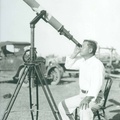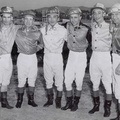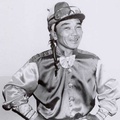Is it Eisenhauer or Eisenhower? Gonzalez or Gonzales? Yasuzo or Yasudo? Whether they are misspellings, attempts at assimilation, or expressions of individualism, the variations in the spelling of immigrant names make up a distinctive feature of the American experience. (By the way, that is why I am not keen on the idea of standardizing the spelling of Nikkei names – say, in accordance with the modified Hepburn system – for bibliographies and even library and archival collections.)
Nikkei name culture begins with the romanization of Japanese names. Upon arriving in America, the Issei had to learn how to write their names in an alphabet with which they were not familiar. Likewise, with the influx of Japanese immigrants at the beginning of the twentieth century, mainstream Americans encountered names that they did not know how to spell. What resulted was a great deal of variation in the spelling of Japanese names, which does not always conform to present-day standards of romanization.
Among farm families in the Imperial Valley, California, Issei women typically bore their children at home with the aid of a midwife. A day or two later, a doctor would call on the mother and baby. It was at that time that the doctor would take down the information for the newborn’s birth certificate. (Incidentally, it was not uncommon for the doctor to record the day of his visit as the baby’s date of birth.) One could imagine that a Hakujin (white) doctor’s unfamiliarity with the Japanese language would lead to a wide range of spellings of Japanese names. Family friend Oscar Kodama told me that his Japanese name was supposed to be Yasuzo but the doctor spelled it with a “d” instead of a “z.” Oscar bemoaned, “There’s no such name as Yasudo but I have to go by it since it’s on the birth certificate.”
Another reason for variations in spelling is that macrons, indicating a long vowel sound, are not generally used in the romanization of Japanese proper nouns. One of the two most common surnames in Japan is Satō (the other being Suzuki). Among Japanese Americans, I’ve seen the name written as Sato (without the macron) or with the addition of a final consonant to indicate the long vowel sound, as in Satoh or Satow.
To signify the long “o” sound, members of my cousin’s family spell their name Mouri (毛利) with the added “u,” and that distinguishes it from the name Mori (森), which does not have a long vowel.
I am acquainted with a family with the surname Eddow (the standard romanization would be Edo). I do not know how the spelling of that name originated, but when I see certain names I wonder if the motivation among some families was to “Americanize” the spelling as a sign of assimilation.
Kumezo Hatchimonji was a Columbia University graduate. His name is printed as Hachimonji on his diploma. According to his son Mike, at some point after Kumezo graduated he began adding a “t” to his surname as in the English word “hatch.”
There were some Issei who intentionally varied the romanization of their names for the express purpose of making them unique. A prominent community and business leader in Southern California, Ayaka Takahash (not Takahashi), appears to have had a penchant for dropping the last vowel from names. He not only spelled his surname without an “i” at the end, but he also named his son Osam (not Osami or Osamu), which his family pronounced “oh” followed by “sam” as in Uncle Sam.
The Dreaded Kanji
One of the greatest challenges presented by Japanese names is the obscure reading of some kanji characters that can make up a name. An Issei owner of a produce company in Brawley, California, provides an extreme case. His name was Zenei Kadekaru and he hailed from Okinawa. Even his Issei contemporaries had difficulty reading the kanji for his surname Kadekaru (嘉手苅). Not only was it a terrible nuisance to him, but it could have also gone so far as to hamper his business. Consequently, around 1938 he changed his surname to one much simpler to read – Nakaya (中谷).
In addition to obscure readings, kanji characters have multiple alternative readings. The only surefire way of discovering the correct reading of a name is through firsthand knowledge, which is not always possible. This can be especially problematic for researchers.
Moriyama was the surname of the first Issei who settled in the Imperial Valley in 1904. His personal name was 昌業. The first kanji character 昌 can be read at least nine different ways. The second character 業 may have at least ten different readings. Moriyama’s personal name is printed as Masanari in an English translation of Shiro Fujioka’s Ayumi no ato, and as Masayoshi in Masakazu Iwata’s Planted in Good Soil. I have deduced that the actual reading should be Shogyo. To the unsuspecting eye, it would be easy to think that the different names referred to separate individuals, possibly brothers.
It is quite rare, but I have come across two instances where members of the same family adopted alternative readings of their surname. I was talking to a family friend about a Nisei fellow whose surname was Miyagi. It was just by chance that in the same conversation I mentioned another Nisei named Miyashiro. My friend said, “You know that they are brothers.” I had no idea! For some reason the two brothers opted for different readings of the same kanji characters that make up their surname (宮城).
© 2017 Tim Asamen






